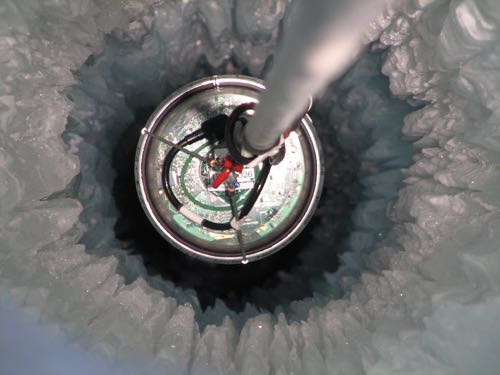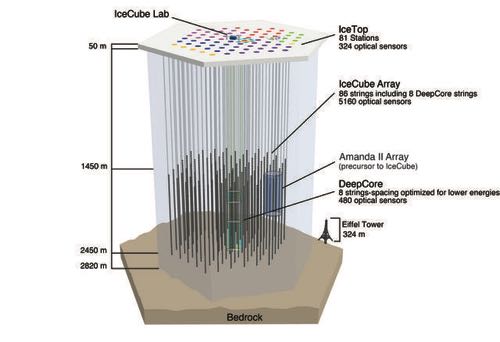A Really Big Telescope
As described in my previous journal IceCube is looking for signature blue light pattern that comes from a neutrino. Of course, this light only shows up when a neutrino hits the nucleus of an atom. This happens very rarely, so we had to build a really big detector in order to increase our chances of seeing one.
How big? About a cubic kilometer big! In fact, the ice in this area weighs more than all the people on earth. Woah.
An Array of DOMs
Remember the DOM – Digital Optical Module? That’s the instrument that detects light.
Now imagine a string…well actually a very thick Erikson cable. Start by hanging one DOM on it. Secure it really tight. Then put another DOM 55 ft (17 m) below it. And another and another, until the string has 60 DOMs attached to it.
Repeat this for a total of 86 strings and you have a lot of DOMs.
Now lower these strings of DOMs deep down into the ice to a depth of between 0.9 miles (1450m) to 1.5 miles (2450m). We’re talking ice that’s 40,000 years old (or older) down here!
 A view of a DOM being lowered into a hole. (Credit: Jim Haugen, IceCube/NSF)
A view of a DOM being lowered into a hole. (Credit: Jim Haugen, IceCube/NSF)
Down here, the ice is super clear – in fact, it’s the clearest ice in the world. Clearer than the glass in the glasses you may be wearing. You see, down this deep all the little air bubbles and impurities in the ice have been squeezed out by the pressure from the ice and snow above. With the ice so clear, light can easily travel without any weird curves. In fact, the ice has an attenuation length of 80-100m – nearly half the light will make it to you if it came form a football field away. Not bad!
And voila! You have an array of over 5000 DOMs deep in the super clear ice ready for a neutrino to stop by.
 A complete view of the IceCube array of DOMs sitting deep in the ice. (Credit: IceCube Collaboration)
A complete view of the IceCube array of DOMs sitting deep in the ice. (Credit: IceCube Collaboration)
Fun fact, IceCube actually isn’t a cube at all. The footprint is actually a hexagon. I guess IceHexagon didn’t have quite as nice of a ring to it though.
A Detection
What does an actual detection look like? Kind of a like a Christmas tree lighting up in a very specific pattern.
The detection shown in the video below is called “Big Bird” (all of the early events are named after Muppets – Bert & Ernie are my favorites). Big Bird was detected in 2012 and is the highest energy event to deposit its energy in the array.
In the video, each dot represents a DOM. When a DOM detects light, a bubble appears. The size of the bubble corresponds to the amount of energy; bigger bubbles show higher energies and smaller bubbles show lower energies. The color of the bubble shows time; red bubbles happened first, orange bubbles second, and blue bubbles happened last.
This entire event lasted just a few microseconds. Now that’s fast!
Why should we care about Neutrinos?
In the 17th century Galileo built the first telescope. As he peered through, he started to see the cosmos in a new and different way given this new and different tool. In fact, Galileo discovered four of Jupiter’s largest moons, now called the Galilean moons. This discovery led to a shift from thinking we were the center of the universe, to realizing that we are not.
With Galileo’s new tool, he learned something about the universe. We’re also trying to learn something new about the universe, using the lens of neutrinos.
Remember, neutrinos are unique. Because neutrinos are chargeless and nearly massless, when we detect one, we can trace a straight line back to its source. Events like gamma ray bursts, stars exploding and going supernova, and active galactic nuclei are likely sources of neutrinos. How crazy is it that by looking at one of the smallest particles in the universe, we can learn about some of the massive explosions happening in space!
A Great Summary
I know that’s a lot of information to absorb at once. Luckily, former PolarTREC teacher Casey O’Hara created an awesome video that effectively summarizes IceCube. Take a look here:


Comments
Add new comment